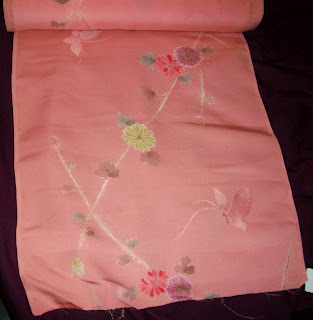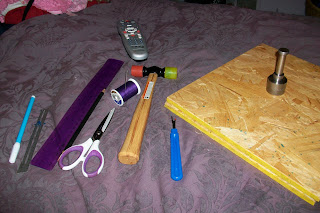Anthony's hat for his black mage costumes is done! Very exciting. I was a little nervous about making this hat, but in the end it turned out well, I think.
Clearly, that's not him, but I'll get a pick of him in the hat yet!
Anyone interested in a tutorial?
18 October 2010
Black Mage Hat
Slapped onto page by; ♥Mistress Rivkah♥ at 2:11 PMrandom associated words: Black Mage, Black Mage Hat, Felt, Final Fantasy, halloween. FF III, Hat, Yellow
14 October 2010
Wark!
Slapped onto page by; ♥Mistress Rivkah♥ at 9:04 PM.
___/),.._
/' ,. ."'._
( "' '-.__"-._ ,-
\'='='), 3\ -._-"-. -"/
/ ""/"\,_\,__"" _" /,-
/ / -" _/"/
/ | ._\\ |\ |_.".-" /
/ | __\)|)|),/|_." _,."
7 \_." " ") | ).-""---''--
( "/.""7__-""''
| 3 ."._--._
\ \ (_ __ "" ".,_
\.,. \ "" -"".-"
".,_, (",_-,,,-".-
"'-,\_ __,-"
",)" ")
/"\-"
,"\/
_,.__/"\/_
ctr / \) "./, ".
--/---"---" "-) )----
random associated words: ASCII, chocobo, Final Fantasy, wark
12 October 2010
Ichiroya Review
Slapped onto page by; ♥Mistress Rivkah♥ at 7:14 PM
Size Width: 14.5" Length: 472.5"
History: quite new
Condition: excellent
Price$78.00 $38.00
Fabric as pictured on website:
Fabric as arrived:
05 October 2010
Halloween Costumes!
Slapped onto page by; ♥Mistress Rivkah♥ at 10:47 PM
random associated words: halloween. FF III, lolita, red, white, white mage
04 October 2010
Cable Stitch Leg Warmers
Slapped onto page by; ♥Mistress Rivkah♥ at 2:11 AM
random associated words: cable stitch, knifty knitter, leg warmers, pink, purple. loom kniting
03 October 2010
Update
Slapped onto page by; ♥Mistress Rivkah♥ at 10:42 PM
Okay, I know, I havn't made a report in forever. School started up and work geared up and wow, have I been busy! Here's an update for you if you're interested:
1.My dress is nearly done. The overskirt needs to be hemmed, snaps sewed onto the forepart, snaps sewed onto the removable sleeves, and pearls to adorn the lace on the sleeves.
2. Anthony's outfit needs a lining, a collar, some trim, and to be hemmed. I suppose he needs trousers too. . .
I'm going to go work on those legwarmers some more, but before I go for now, let me leave you with a list of things to come:
1. Pictures and pattern review of finished Elizabethan gown
2. Pictures of Anthony's finished outfit (pattern was self-drafted)
3. Pictures and possible pattern for leg warmers (time depended – pictures for sure though)
4. Seller review for http://www.ichiroya.com/
5. Waloli dress drawing board
random associated words: update
24 September 2010
I made you a cookie!
Slapped onto page by; ♥Mistress Rivkah♥ at 12:26 PM
I know - I haven't been around for AGES. Will it make you feel better if I tell you how to turn cake mix into cookies?
What you need:
- 1 box of cake mix (any flavour you'd like)
- ½ cup of fat – this can be any kind of oil, slightly melted butter or margarine
- 2 large eggs
- 1 tsp of vanilla extract
- Chocolate chips and/or nuts (optional)
How to make your cake into a cookie:
- Preheat oven to 350°
- Put your oil/butter into a bowl. Add eggs and whip together. Add vanilla, whip one last time (I used an electric blender, but it's not necessary)
- Empty contents of cake mix into your wet ingredients. Stir until all the cake mix is incorporated.
- Add nuts and/or chips
- Grease / cookie-proof your bake sheet
- Drop cookies mix by rounded spoonful onto sheet.
- Bake for 10 – 14 min – or until cookies are a light golden brown. Do not over bake, they'll get really hard and crumbly.
Instead of butter or oil for fat try ½ c of:
- Applesauce
- Purred banana
- Pureed pumpkin
Try adding seasonal spices to your mix like pumpkin pie spice
Add some dried fruit or oatmeal to your cookies for a yummy trail mix treat,
Get creative and have fun!
10 August 2010
Moving on
Slapped onto page by; ♥Mistress Rivkah♥ at 2:16 PM
 |
| Woah! too big! |
 |
| Those pins make a tailored torso! |
 | |
| The blue line means, "Cut here so you can more your arms!" |
 |
| The needed seams in dashes |
 |
| Connect the dots! |
 |
| Cut on the blue one! |
 |
| Ah, perfection! |
random associated words: bodice, corset, elizabethan gown, fitting
Bound Eyelet – Type 1
Slapped onto page by; ♥Mistress Rivkah♥ at 1:31 PM
Find your eyelet channel. Take the ruler and with your dressmaker's pen draw a line from top to bottom of the corset right down the middle. This will let you set your eyelets in a nice strait line.
Decide how your eyelets will be spaced. Take your seam gauge and dressmaker's pen and plot out where your eyelets will be.
Holes all in? Good. Grab your thread and needle and cut a very long piece of thread. Then match cut end to cut end of thread and put both cut ends through the needle. Tie all cut ends to the loop side so that you're sewing with 4 threads instead of one or two.
random associated words: bound eyelet, corset, eylets, underpinings
05 August 2010
Bound to You
Slapped onto page by; ♥Mistress Rivkah♥ at 3:50 PM
random associated words: Asian design, corset, purple, underpinings
04 August 2010
Hell Dress
Slapped onto page by; ♥Mistress Rivkah♥ at 12:54 AM
 |
| Back |
random associated words: flowers, hell dress, lolita, lolita dress, red
28 July 2010
Sketchy Business
Slapped onto page by; ♥Mistress Rivkah♥ at 6:28 PM
 |
| who needs a face, arms or legs? |
Idle Hands. . .
Slapped onto page by; ♥Mistress Rivkah♥ at 4:04 PM
 I'm bored. . . no bones, no work today, no Otakon to get ready for – what a bummer! I found this fabric in my stash. It's cute. I was going to make a petticoat out of it for a client, but she reneged and luckily I hadn't cut into it yet. I estimate I have about 3 ½ yds. I am soo yearning for Otakon – the cosplay, the pictures, the people, the anime, the wandering around in Baltimore all dressed up and getting odd reactions, the good time with friends – why oh why must I be poor?!?! Damned economy >:[ I'm digressing here, sorry. Okay, pining for Otakon, have 3 ½ ish yards of Lolita-like fabric. . . so why not make a pretty summery Loli dress?
I'm bored. . . no bones, no work today, no Otakon to get ready for – what a bummer! I found this fabric in my stash. It's cute. I was going to make a petticoat out of it for a client, but she reneged and luckily I hadn't cut into it yet. I estimate I have about 3 ½ yds. I am soo yearning for Otakon – the cosplay, the pictures, the people, the anime, the wandering around in Baltimore all dressed up and getting odd reactions, the good time with friends – why oh why must I be poor?!?! Damned economy >:[ I'm digressing here, sorry. Okay, pining for Otakon, have 3 ½ ish yards of Lolita-like fabric. . . so why not make a pretty summery Loli dress?
Summer appropriate
the print dictates this
no sleeves or cap sleeves
knee length skirt
full skirt – I have some crinoline if needed
nothing too "crazy"
I don't want to spend too much. I haven't worked all week and school will be starting in a month. I'd like to spend no more than a few dollars on a zipper or smocked fabric so that I can, you know get in and out of the completed garment.
 |
| Yay! Options! |
random associated words: bored, fabric stash, lolita, red
Appliqué
Slapped onto page by; ♥Mistress Rivkah♥ at 1:46 PM
She's done! Last night I finished my little Gaia avatar appliqué. I used only materials in my house and she turned out so nicely. What do you think?
 |
| Great for any background! |
 Maybe I'll make appliqués for my Gaian friends next. . .
Maybe I'll make appliqués for my Gaian friends next. . . random associated words: applique, avatar art, Gaia
27 July 2010
Busy Work
Slapped onto page by; ♥Mistress Rivkah♥ at 4:33 PM
random associated words: avatar art, Gaia
European Alternatives
Slapped onto page by; ♥Mistress Rivkah♥ at 1:38 PM
 |
| Think Jackie Chan in Shanghai Noon - Same idea, different time period |
Skeletal Anatomy of a New Corset
Slapped onto page by; ♥Mistress Rivkah♥ at 1:12 PM
 |
| Gap at side of bust |
 |
| Back - you can see the bones only extend as far as the side seams |
 |
| Finally the white pencil has its day! |
random associated words: boning, corset, purple, underpinings
23 July 2010
Needle Pointers
Slapped onto page by; ♥Mistress Rivkah♥ at 3:13 PM
22 July 2010
Decisions
Slapped onto page by; ♥Mistress Rivkah♥ at 11:25 PMrandom associated words: corset, purple, renaissance fair, Tudor Tailor, underpinings











































